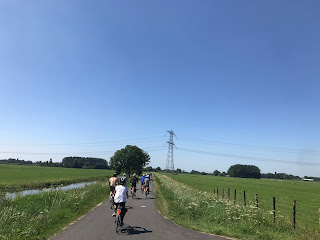Tuesday was our last morning in Utrecht and our first day in Amsterdam. How'd we get to Amsterdam you ask? We biked of course! We saddled up our touring bikes one last time and rode 44 KM north to Amsterdam.
I'd have to say that if I ranked all four of our long bike tours, this one would be number one. This is for a few reasons; the main one being separation from car traffic. We were rarely near roads or streets with cars on them, and when we were the vehicles came few and far between. This really helped me enjoy my ride through the Dutch countryside, in fact, I often found myself feeling like it was just a bike ride, not a commute. This was a stark contrast from the previous rides where it was hard to forget we were commuting from one place to another. Not to say I didn't like the other rides, but when there are now cars around you, you have the ability to let your mind wander a lot more. This is one of my favorite parts of long-distance bike rides, it's kind of like taking a two-hour-long deep breath.
Another thing that surprised me how good the bicycle infrastructure was throughout Amsterdam. As soon as we hit the outskirts of the city the red asphalt and bike stoplights began to show up. Even better was the fact they weren't few and far between either, the infrastructure was showing up just as commonly as it does in the city center. This shows that the city is trying to make it possible for everyone to commute by bike if they want. It's so awesome to see a whole country make an effort to allow people to get anywhere from anywhere by bike. Whether it be from city to city, a suburb to cit, or trips within a city, you can bike. This kind of holistic thinking is how you make large scale differences and changes. It gives me some hope that people can really make a change in the world of transportation.

Comments
Post a Comment